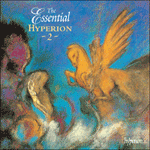
Welcome to Hyperion Records, a British classical label devoted to presenting high-quality recordings of music of all styles and from all periods from the twelfth century to the twenty-first.
Hyperion offers both CDs, and downloads in a number of formats. The site is also available in several languages.
Please use the dropdown buttons to set your preferred options, or use the checkbox to accept the defaults.

A winged poetry permeates the five-finger chromatic figures of No 2, Traits chromatiques. Surely Debussy had this étude somewhere in his subconscious when he wrote his étude, Pour les degrés chromatiques?
A rather more angular Prélude et Fugue in E flat minor displaces the impressionistic world of the first two études. Shifting quaver chords agitate a courageous, thrusting theme in the prelude, which eventually quietens into a thoughtful fugue subject, taken up in four voices and rounded off by a big finish. The seductive world of the Canary Islands is conjured up by No 4, Les cloches de Las Palmas. Repetition and the creation of atmosphere are the technical exercises involved—a rather imaginative tone poem is the result.
No 5, Tierces majeures chromatiques, again delights in the difficulty of thirds—this time major chromatic thirds. A sense of humour inflects its moto perpetuo feel. It is dedicated to Édouard Risler, probably the first truly great French-trained pianist, after Saint-Saëns himself, and a major artistic influence on Alfred Cortot.
As with Opus 52, the best piece is sensibly saved for last. The Toccata d’après le 5e Concerto is dedicated to Raoul Pugno, renowned for his brilliant deftness. Its themes, as the title suggests, are from Saint-Saëns’ Piano Concerto No 5 (the third movement), composed three years before this étude. It pre-dates the toccatas of Debussy, Ravel and Prokofiev and has comical references to ragtime, which, in those years, was traversing the Atlantic to fervent European welcome. Octaves, left-hand leaps and arpeggiated chords are despatched with authentic pianistic imagination. It is a tour de force and deserving of a wider audience.
from notes by Piers Lane © 1998
Les figures chromatiques à cinq doigts de la pièce no2, les Traits chromatiques, sont empreintes d’une poésie légère. Debussy s’en inspira certainement, au moins inconsciemment, lorsqu’il composa son étude pour les degrés chromatiques.
Un Prélude et Fugue en mi bémol mineur, plus anguleux, disperse l’univers impressionniste des deux premières études. Des accords en croches agitato soutiennent le thème hardi et audacieux du Prélude, qui s’apaise progressivement pour laisser place à un sujet de Fugue mélancolique à quatre voix, parachevé par un grand finale. Les cloches de Las Palmas (no4) évoque l’univers séduisant des Îles Canaries. Les exercices techniques exigés par le morceau—répétition et jeu atmosphérique—débouchent sur une pièce caractéristique plutôt original.
La pièce no5, Tierces majeures chromatiques, est elle aussi admirable pour la difficulté de ses tierces—il s’agit cette fois de tierces chromatiques majeures. L’impression de moto perpetuo qu’elle dégage lui confère une tournure plutôt humoristique. Elle est dédiée à Édouard Risler, influence artistique majeure d’Alfred Cortot, et probablement après Saint-Saëns le premier grand pianiste formé en France.
Comme dans l’opus 52, on garde le meilleur pour la fin. La Toccata d’après le 5ème Concerto est dédiée à Raoul Pugno, renommé pour son extrême virtuosité. Les thèmes de la pièce, comme le suggère son titre, s’inspirent du troisième mouvement du concerto pour piano de Saint-Saëns, composé trois ans auparavant. Elle annonce les toccatas de Debussy, Ravel et Prokofiev, et fait référence de manière spirituelle au ragtime, qui à l’époque venait de traverser l’Atlantique et recevait en Europe un accueil fervent. Octaves, sauts de la main gauche et accords arpégés se mêlent avec une imagination toute pianistique. Il s’agit d’un tour de force, qui mériterait d’être mieux connu.
extrait des notes rédigées par Piers Lane © 1998
Français: Sylvie Cappon
Eine beschwingte Poesie druchdringt die fünffingrigen chromatischen Figuren der Nr. 2, Traits chromatiques. Gewiß hatte Debussy diese Etüde irgendwo im Unterbewußtsein gespeichert, als er seine Étude pour les degrés chromatiques schrieb?
Ein erheblich kantigeres Präludium und Fuge in es-Moll verdrängt die impressionistische Welt der ersten beiden Etüden. Sich verlagernde Achtelakkorde regen im Präludium ein beherztes, schwungvolles Thema an, schließlich ruhiger werdend in ein nachdenkliches Fugensubjekt verwandelt, das von vier Stimmen aufgegriffen und mit einem großen Finale abgerundet wird. Die reizvolle Welt der kanarischen Inseln wird von der Nr. 4 mit dem Titel Les cloches de Las Palmas heraufbeschworen. Wiederholung und das Schaffen von Atmosphäre sind die technischen Übungen, um die es geht—ein recht einfallsreiches Tongedicht ist das Ergebnis.
Tierces majeures chromatiques, die Nr. 5, ergötzt sich wiederum an der Schwierigkeit von Terzen—diesmal sind es chromatische große Terzen. Ihre Moto-perpetuo-Stimmung ist mit Humor befrachtet. Das Stück ist Édouard Risler gewidmet, dem wohl ersten wahrhaft großen in Frankreich ausgebildeten Pianisten nach Saint-Saëns, der einen wesentlichen künstlerischen Einfluß auf Alfred Cortot ausgeübt hat.
Wie bei Opus 52 wird das beste Stück vernünftigerweise bis zum Schluß aufgespart. Die Toccata d’après le 5e Concerto ist Raoul Pugno gewidmet, der für seine besondere Gewandtheit berühmt war. Ihre Themen stammen wie im Titel angedeutet aus dem dritten Satz des drei Jahre vor dieser Etüde komponierten Klavierkonzerts von Saint-Saëns. Sie ist vor den Toccaten von Debussy, Ravel und Prokofjew entstanden und enthält launige Anspielungen auf den Ragtime, der damals über den Atlantik kommend in Europa begeistert willkommen geheißen wurde. Oktaven, Intervallsprünge der linken Hand und arpeggierte Akkorde werden mit wahrem pianistischem Einfallsreichtum eingesetzt. Das Stück ist eine Glanzleistung und hat es verdient, einem breiteren Publikum nahegebracht zu werden.
aus dem Begleittext von Piers Lane © 1998
Deutsch: Anne Steeb/Bernd Müller
 The Essential Hyperion, Vol. 2 The Essential Hyperion, Vol. 2'More than just a highlight sampler. This is a classy collection, brought together with a great deal of care and attention to musical programming seldom found in this kind of CD … A stocking-filler any music lover would appreciate' (Scotland ...» More |

